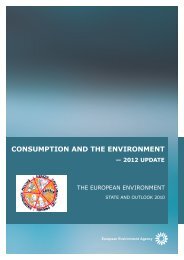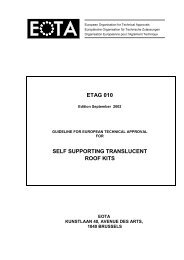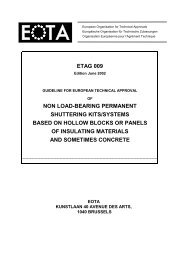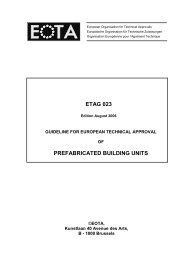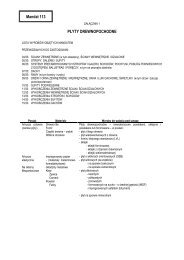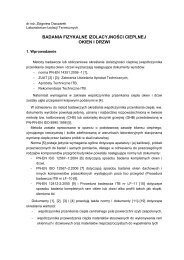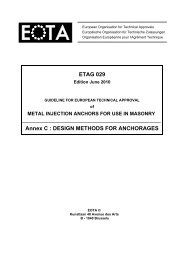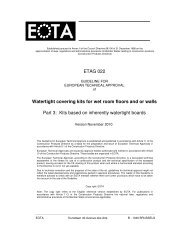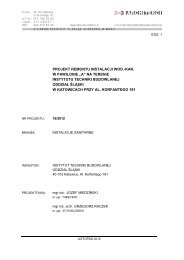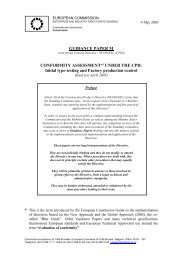ETAG 001
ETAG 001
ETAG 001
You also want an ePaper? Increase the reach of your titles
YUMPU automatically turns print PDFs into web optimized ePapers that Google loves.
the influencing factors the failure mode may change (e.g. tests with “concrete cone failure” at 20° C and“combined pull-out and concrete cone failure” at 80° C show lower performance at 80° C). If the tests areperformed in such a way that “combined pull-out and concrete cone failure” is observed (e.g. at 20° C and 80° C)the largest difference in performance is observed. This influencing factor is decisive for the evaluation of abonded anchor system.So the main aim of the test regime is to establish a resistance for “combined pull-out and concrete cone failure” -if required, modified by the influencing factors-, which is published as Rk in the ETA. The characteristic bondresistance allows a design of bonded anchors for “combined pull-out and concrete cone” resistance at variableembedment depth with or without group- or edge effects. The resistance for “concrete cone” and “steel failure”can be calculated according to current experience.To avoid “steel failure” in the tests embedded parts of a higher strength than specified by the manufacturer andpublished in the ETA may be used as long as the functioning of the anchor is not influenced. This condition isfulfilled if the geometry of the embedded part of higher strength steel is identical with the specified embeddedpart.In cases where the use of high strength anchor elements (steel strength ≥ 10.9) is insufficient to prevent “steelfailure” the anchor embedment depth shall be reduced. This principle may overrule the required embedmentdepth for the suitability tests (5.1.2) and admissible service condition tests (5.1.3).Special conditions for tests according to line 1 of Table 5.1 or 5.2 are given in 5.1.2.The unconfined tests with minimum specified embedment depth in the admissible service condition tests mayshow “concrete cone failure”. If these results are used for evaluating the characteristic bond resistance(eventually modified by the various influencing factors) the approach is conservative. More precise results maybe achieved if the minimum embedment depth is chosen in a way that bond failure (“combined p ull-out andconcrete cone failure”) is decisive.Bonded anchors with a high bond resistance may show only “concrete cone failure” or “steel failure” inunconfined tests. In this case it is recommended to perform all tests as confined tests and to evaluate Rk takingthe modification factor αsetup into account (see Equation 6.17.1).For the assessment of a bonded anchor the overall test programme has to be carried out including at least thefollowing minimum number of different concrete batches within the programme of testing:Assessment for C20/25:Assessment for C50/60:on at least 3 different batches, if the concrete comes from differentconcrete supplierson at least 4 different batches, if the concrete comes from the sameconcrete supplieron at least 2 different batches, if the concrete comes from the same or fromdifferent concrete suppliers.If concrete batches come from the same concrete supplier it shall be ensured that each batch is made from adifferent delivery of either cement or aggregates.Reference Tension Tests (R) shall be performed because they are needed for the evaluation of the results of thesuitability tests and to take account of the influence of certain parameters on the tension load resistance ofbonded anchors. They shall be made in each batch. All reference tests shall be carried out as follows: in dry concrete at normal ambient temperature (T = + 21° C + 3 °C)anchor installation in accordance with the manufacturer’s published instructionsas confined test; they shall be made at approximately the same curing time as the correspondingsuitability tests or tests for admissible service condition.In general, the reference tests shall be made in the same concrete batch as the tests to which they shall becompared (for exception, see note (6) in Table 5.1 and note (4) in Table 5.2). The reference tests shall be madein non-cracked concrete (cracked concrete, w = 0,3mm), if their results shall be compared with results of testsin non-cracked concrete (cracked concrete).It is necessary to carry out at least 5 reference tests in each series. If the coefficient of variation of the failureloads is > 15 %, then the number of reference tests shall be increased.<strong>ETAG</strong> <strong>001</strong>-5- 10 -




